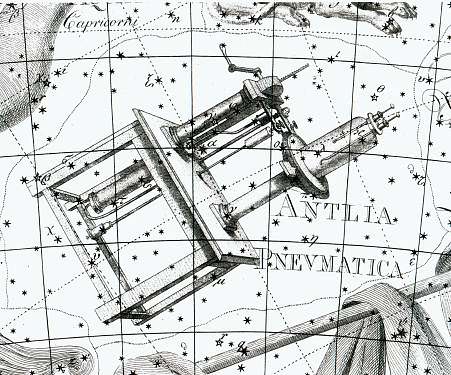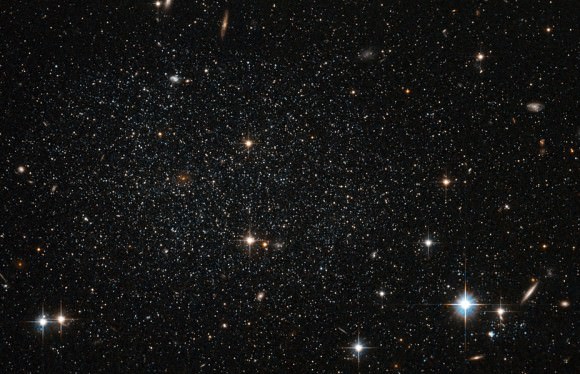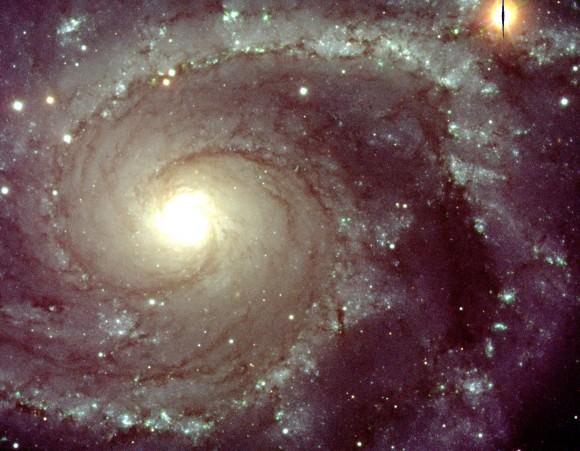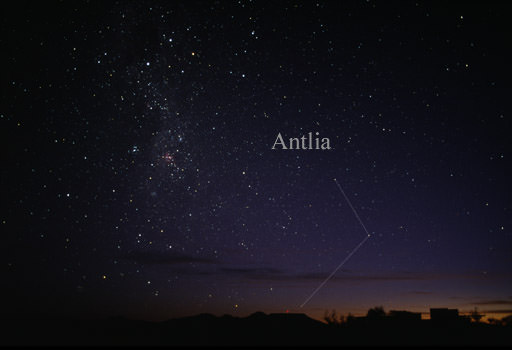In the 2nd century CE, Greek-Egyptian astronomer Claudius Ptolemaeus (aka. Ptolemy) compiled a list of the then-known 48 constellations. His treatise, known as the Almagest, would be used by medieval European and Islamic scholars for over a thousand years to come. Thanks to the development of modern telescopes and astronomy, this list was amended by the early 20th century to include the 88 constellation that are recognized by the International Astronomical Union (IAU) today.
One such constellation is Antlia, who’s name means “the Pump”. Discovered by French astronomer Nicolas Louis de Lacaille in the mid-eighteenth century, Antlia is located in a rather remote and open section of the southern skies, and was used to chart the southern hemisphere. Today, it is one of the 88 constellations recognized by the IAU.
Name and Meaning:
As noted, it was French astronomer Nicolas Louis de Lacaille who first wrote of the existence of Antlia while cataloging stars of the southern hemisphere. This he did during his two-year stay in the Cape of Good Hope in modern-day South Africa. In 1751-52, he referred to it as “la Machine Pneumatique” (“the Pneumatic Pump”), in reference to the air pump which had been invented by physicist Denis Papin.

As with the majority of the constellations he observed in the southern hemisphere (none of which were visible in Europe), Antlia was named after a modern invention that symbolized the “Age of Enlightenment”. This effectively discontinued the process of giving constellations names derived fro classical mythology.
When creating his constellation chart in 1763, Lacaille Latinized the name to Antlia pneumatica. English astronomer John Herschel would later suggest that the name be shorted to one word, and the name Antlia quickly caught on with the astronomical community. German astronomer Johann Bode would later include it in his own constellation guide, where he depicted it as a double-cylinder pump (as opposed to the earlier single pump version used by Lacaille).
History of Observation:
Though Antlia was technically visible to ancient Greek astronomers, its stars were too faint to have been included in any constellations. In addition, Chinese astronomers were able to view Antlia, and incorporated its stars into two different constellations – “Dong’ou”, which represented an area in southern China, and “Tianmiào”, the celestial temple.
However, it would not be until the mid-18th century that it would come to be included in any modern star charts or constellation guides. Today, Antlia ranks as the 62nd of the 88 modern constellations in terms of area. The three-letter abbreviation for the constellation, as adopted by the International Astronomical Union in 1922, is ‘Ant’.

Notable Features:
Within the constellation’s borders, there are 42 stars brighter than or equal to apparent magnitude 6.5. The constellations brightest star, Alpha Antliae, is an orange giant of spectral type K4III that is a suspected variable star. It is located approximately 350 – 390 light-years away from Earth; and based on its high luminosity (480 – 555 times that of the Sun), it is believed to be an aging star currently in its red giant phase.
Located near Alpha is Delta Antliae, a binary star that is between 400 and 460 light-years from Earth. The primary is a blue-white main sequence star while the secondary is an yellow-white main sequence star. Then there is Zeta Antliae, a wide optical double star that is located between 360 and 450 light years from Earth.
The brighter of the two, Zeta Antliae, is itself a binary star consisting of two white main sequence stars that is between 360 and 450 light years from Earth. The fainter of the two, Zeta² Antliae, is 360 to 400 light years distant. Eta Antliae is also a binary star, the brighter component being a yellow-white star with a faint companion. Both are 106 light years distant.
Theta Antliae is another binary star system, which consists of a white main sequence dwarf and a yellow-white bright giant. It is located approximately 384 light years away. Epsilon Antliae, an evolved orange giant star, is located approximately 700 light years distant. At the other end of the constellation is Iota Antliae, another orange giant star.

Also of interest is HD 93083, a star which contains an recently-discovered exoplanet that may be habitable. Known as HD 93083 b, this world is described as a “Sulfurous Cloud Jovian Planet” which exists at the inner edge of the star;s habitable zone (at a mean orbital distance of 0.47 AU). The planet was discovered in 2005 by C. Lovis, M. Mayor, F. Pepe, D. Queloz, N.C. Santos, D. Sosnowska, S. Udry, W. Benz, J.-L. Bertaux, F. Bouchy, C. Mordasini, J.P. Sivan.
Because it occupies a part of space that faces away from the Milky Way, Antlia is also to very few Deep Sky Objects. While it contains no globular clusters, no planetary nebulae, and no open clusters, it does contain several galaxies. These include the Antlia Dwarf Galaxy (above), a dwarf spheroidal galaxy located about 4.3 million light years from Earth. Because it is very faint, this galaxy was not discovered until 1997, and belongs to the Local Group of galaxies.
NGC 2997 is another, a “grand design”, unbarred spiral galaxy located approximately 24.8 million light years away. NGC 2997 is the brighest object in the Antlia constellation, due in part to the large chain of hot, ionized dust clouds that surround the galaxy’s nucleus. NGC 2997 is part of a group of galaxies of the same designation, which belong to the Virgo Supercluster.
There’s also the Antlia Cluster (aka. Abell S0636), a cluster of galaxies located 133.4 million light-years from Earth. As part of the Hydra-Centaurus Supercluster, it is the third nearest cluster eto the Local Group after the Virgo Supercluster and Fornax Cluster. Located in the southeastern corner of Atlia, it contains the giant elliptical galaxies NGC 3268 and NGC 3258, the main members of a southern and northern subgroup, respectively.

Finding Antlia:
Located in the southern hemisphere, Antlia is bordered by Hydra the sea snake to the north, Pyxis the compass to the west, Vela (the sails of the mythological ship Argo) to the south, and Centaurus the centaur to the east. This group of constellations is prominent in the southern sky in late winter and spring. For telescopes, Antlia contains several items of interest.
As noted already, there is NGC 2997, the spiral galaxy which is inclined 45° to our line of sight. The Antlia Dwarf -the 14.8 magnitude dwarf spheroidal galaxy – is also visible with telescopes. For more moderately sized telescopes, look for planetary nebula NGC 3132, also known as the “Eightburst Planetary” or “Southern Ring Nebula”. It is very close to the border with Vela. Seen through a 6-inch scope it appears as an elliptical disk with an apparent size larger than that of the planet Jupiter. At its heart is a very cool binary star!
Using binoculars, one can spot Alpha Antliae easily enough, since it is the brightest star of the constellation, shining away at magnitude 4.2. Now move on to Zeta Antliae, it’s a very wide double star easily split with binoculars into its two components of 6th-magnitude. One of the component stars also has a 7th-magnitude companion. For smaller telescopes, try your hand at 5.2 magnitude double star Eta Antliae. Located 110 light years away from Earth. Its two components (magnitudes 5.2 and a disparate magnitude 12) are separated by 31 arcseconds.
We have written many interesting articles about constellations and Deep Sky Objects here at Universe Today. Here is the Andromeda Constellation, the Virgo Supercluster, and the Local Group.
And be sure to check out our full guide on the subject – What Are The Constellations? – and The Messier Catalog.
For more information, check out the IAUs list of Constellations. and the SEDS page on Antlia.

